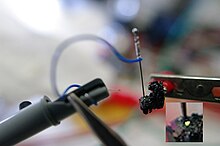Round effect

The round effect (also known as the Lossew effect ) describes the physical phenomenon of light emission from semiconductors when an electrical voltage is applied. The round effect is the basis of the light emitting diode .
history
In 1907, Henry Joseph Round discovered the effect that inorganic substances can emit light when an electrical direct voltage is applied . He published his discovery in Electrical World that same year . There he described how he made a silicon carbide crystal glow in yellow, orange or blue by applying an electrical voltage of 10 volts . He described the emitted light as cold , as no warming of the crystal could be detected. The effect was then forgotten again for a few decades.
The Russian physicist Oleg Vladimirovich Lossew also discovered this effect in 1921, studied and described it from 1927 to 1942. A similar effect on zinc sulfide was discovered in 1935 by Georges Destriau and named after the Russian physicist Lossew-Licht .
literature
- Henry Joseph Round: A note on carborundum . In: Electrical World . tape 19 , 1907, pp. 309 .
Individual evidence
- ↑ Nikolay Zheludev: The life and times of the LED - history a 100-year . In: Nature Photonics . tape 1 , no. 4 , p. 189–192 , doi : 10.1038 / nphoton.2007.34 ( PDF [accessed October 28, 2008]). PDF ( Memento of the original from March 31, 2017 in the Internet Archive ) Info: The archive link was inserted automatically and has not yet been checked. Please check the original and archive link according to the instructions and then remove this notice.